A Nursing handoff report is usually given by one nurse to the other usually when a shift change takes place. It contains all the details with regard to several patients whom the previous nurse had attended. The primary benefit of maintaining this document is that the new nurse can hit the ground running. She does not have to look into every patient and ask them about their preferences, allergies, condition etc.
One common misconception with regard to the nursing handoff report is that it is only applicable in case of a shift change. However, that is not true. Such handoffs can occur at other times too. Handoffs can occur from nursing units to other nursing units or they may occur from nursing units to diagnostic areas. In fact, there are some special settings like operating rooms and emergency departments too where handoffs occur frequently.
Nursing handoffs and their consequences have recently come to limelight. It has been noted that they occur frequently in healthcare setups and careless handoffs can be particularly dangerous. As such, robust systems are being researched, tested and implemented to regulate them.
Contents
Structure and content of the nursing handoff report
A key element of creating proper nursing handoffs report is to ensure that they follow the correct structure and contain relevant content. The structure can be in any chosen format. However, care must be taken that the structure helps in making the report look cohesive. A common format is to start with the basics of the patient like name and gender before moving on to more complicated details like recent behavioural changes and the like.
In terms of content, there is probably no end to detail. However, there are some basic elements which must be present in every report:
- Particulars of the patient like name, gender, age and code status
- List of issues regarding the patient and their individual status
- Medicines being administered to the patient and their schedule
- All tubes drain and other equipment being used
- Patient’s Personal taste and preferences especially allergies
- Information regarding how critical the patient’s condition with regard to mentioned illnesses is
- Significant points in the past medical history of the patient
- Any recent issues or recoveries observed in the patient
- Patient’s diet and other relevant instructions
This, by no means, is enough. In fact, what is enough and what is not will usually be decided by the particular circumstances of the case at hand? Hence, a better approach is to start with basic factors and then add anything of significance found later on.
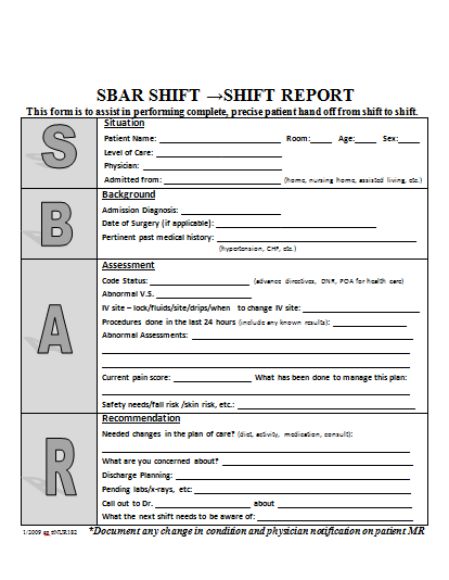
Uses / Importance
Nursing handoff reports might apparently not look very significant. However, they serve a number of objectives in a healthcare environment. Below are some pertinent points which deserve attention:
- Record of the patient’s history: It serves as a written record of the patient’s medical condition as far as his present illness is considered. There is another benefit of having this sheet. Any nurse who takes over will immediately know about the patient’s preferences and will act accordingly. In case the patient is allergic to any particular element, the nurse will ensure that such an element is not served to the patient again.
- Efficient and Smooth Workflows: When a new nurse comes into the picture, she does not know anything about the patient at all. However, once she goes through the handoff report, she can immediately get started. In an ideal case, the patient must not even realize that a shift change has happened.
- Co-ordinated effort: Often bed side report handoffs are used in healthcare environments. What happens in these cases is that the patient, as well as his family, can directly contribute to the creation of the report. As such, the product is a more accurate service.
Lastly, a written handoff report can help in removing any kind of discrepancies or differences which might arrive later on. Hence, a properly drafted handoff can yield great results for the organization.
Critical information in nursing handoff report
No doubt, a nursing handoff report must have as much information as possible. However, there are certain critical issues which should not be ignored at any cost.
- Medications: All the drugs being administered to the patient must be diligently noted along with their timings. Usually, medications play the primary role in curing an individual and thus, they cannot be compromised.
- Tubes and other equipment: The equipment being used for the patient should be written down. As such, the other nurse will be able to ensure they are working properly at all times
- Allergies and relevant medical history: Any specific patient-related information must be taken special care of as they can directly influence the treatment procedures.
- Recent significant signs and Pending treatment: As such, the second nurse would be able to follow up on them and report back.
These critical issues can come in handy as a checklist. Creating a handoff report is often a cumbersome and tedious job. Hence, it is possible that the nurse might not be able to ensure completeness by herself. In this case, a quick glimpse at this list will ensure that she is not missing out on anything valuable.
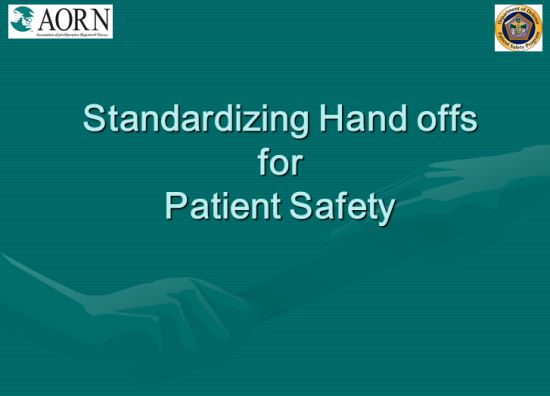
How to fill a nursing handoff report
You might be a very skilful nurse who knows her job well. However, that does not mean that the report you draft will necessarily be great. There are many minute aspects which can create big differences in the effectiveness of your output.
Firstly, try to be as clear as possible with your words. Ambiguity in words or concepts must be reduced to its bare minimum. Time and again we come across nurses who are the best in their field but are not able to explain themselves well enough. To ensure clarity, it is important to use simple words which do leave much scope for doubt. When using abbreviations, make sure you use only the standard ones. Otherwise, try to keep their use to a minimum.
One must also try to write in clearly legible handwriting. As a result, the other nurse would also be interested in going through whatever you have written. Unclear handwriting can be a put-off. In extreme cases, it can even lead to wrong medications being served.
Another simple tip is to make sure you do not try to overly complicate the process. Make sure you only include what is needed and leave out the rest. Also, try to look at things from the perspective of the other nurse. Try to make it simpler for her to understand what has been written.
Handoffs and its implications for nurses
Handoffs can have a completely different set of consequences for nurses than you, as a consumer, can imagine. It plays a key role in every aspect of their job.
- Perform their duties efficiently and accurately: Any seasoned nurse would probably first want to look at the handoffs as soon as she is put in charge of a patient. Nursing handoffs can help them immediately get to know about a particular patient and deliver good service.
- Prevents future mistakes: When a nurse gets to learn from the mistakes of the previous shift personnel, she will probably not repeat the same again.
- An informal test of knowledge and skill: It might seem strange to a regular reader but for nursing, handoffs can often be used to judge the skillets of a nurse. Regular diagnostic errors in these handoffs put a question mark on the credibility of a nurse. Over a period of time, nursing handoffs can influence a nurse’s perception on the hospital floor.
As such, nurses would usually like to keep their handoffs clear and accurate.
Nurse to Nurse Handoff Report
Handoffs can, naturally, be of different types. However, when we talk about nurse to nurse handoffs, we usually mean those handoffs which occur at the end of a nursing shift. These handoffs might look like a simple exchange of documents. However, in a healthcare environment, certain specifics make things complicated:
- Occurs multiple times a day: Nurse to nurse handoffs occur not once or twice but several times a day. Each nurse might attend multiple patients and will have to accordingly handover data to several nurses.
- Occurs for specialized and multi disciplines: As healthcare has advanced and become more specialized, we have seen new disciplines emerge. With novel and unique treatment methods, handoffs have only gotten more diverse and difficult.
- Each report has multiple input sources: The patient, his family and the nurse’s personal observations are only some of the things present in the report. Other than this, a report might contain a number of different issues and particulars too.
That is not it. Other complexities in the environment like workplace issues, communication breakdowns further complicate the nurse to nurse handoffs of reports.
Steps to create effective handoff communication
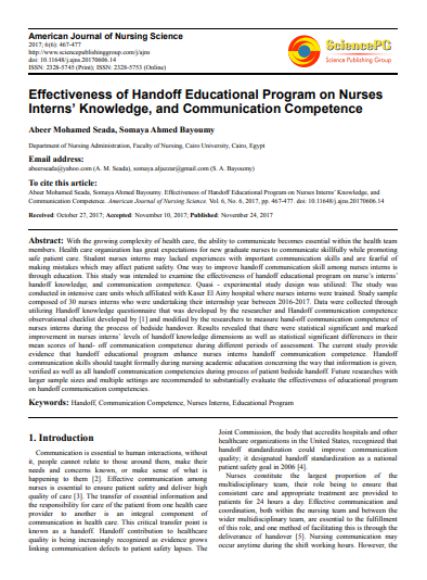
It is always better to have a certain blueprint of activities to be performed in order to accurately carry out a task. Here are a series of steps which any nurse can take if she wants to create effective handoff communication.
- Evaluating critical information: Irrelevant information only serves to distract the other nurse and does not produce anything constructive.
- Filling the report properly: The report must be filled clearly, using accurate terms, including all the critical components.
- Being technology savvy: Using technology tools for better reporting and communication.
- Selecting the right place for handoff: A silent place where one on one interaction is possible should be preferred.
- Making efforts to enable personal communication: Even if one on one communication is not possible, a video call or phone call is usually just one click away.
Also, while receiving the handoff form the previous nurse, one must be patient, let her complete and ask relevant questions.
Importance of effective handoff reporting
The benefits of effective handoff reports are well known to all. However, it is important for more than just that. If handoff reports are not given or if handoffs are made improperly, they can lead to grave consequences.
Improper care in the form of incorrect medication and wrong medication dosage are just the starting points. Besides these, cumbersome handoffs can lead to changes in equipment being used to cure the patient. Injections might be administered to the wrong areas.
Usually, such errors might cause minor discomfort to the patient. However, it can get worse. What if the incorrect medication served reacts in an unfavourable way? It might then require urgent measures. In extreme cases, it might even lead to the death of a patient.
Healthcare environments are always full of risks and uncertainties. As such, any step which helps bring all factors under control must be given utmost importance.
What is the handoff procedure
The handoff procedure is a long one in practice. However, it contains certain key elements which remain the same always.
- The nurse will write all key points regarding the patient: Such notes are taken clearly and regularly throughout the entire shift. With time, there has been changing in the way just points are recorded. Today, many organizations use electronic devices to record key points too.
- Prepare final report when it is time for handover: Finally, the report is completed and any missing information is noted. It is then handed over to the recipient.
- Written and oral communication: Between giver and receiver, there is usually a two-way communication while the handoffs are transferred. The giver might give all relevant details and explanations. On the other hand, the receiver might ask relevant questions as needed.
- New personnel take over document and reports: Finally, the recipient would use the document to fulfil his or her own duties. At times, he or she might report back on the content mentioned in the report.
These handoffs do not always have to between nurses. They can be to a diagnostic lab or a doctor too. Also, the procedure might undergo changes in accordance with the circumstances governing the situation at hand.
What is a patient handoff
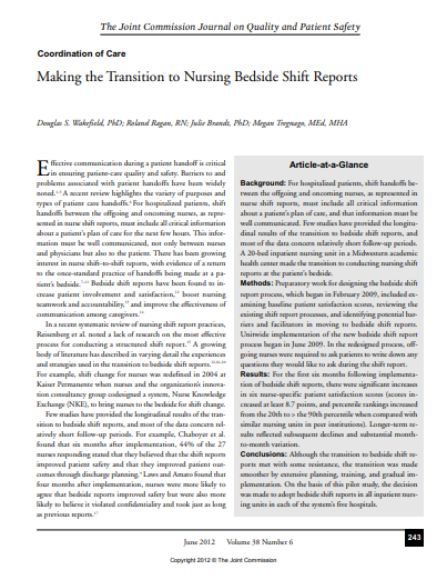
In general, the term patient handoff means only what one might expect. It entails the transfer of a patient from the charge of one person to the other. However, if we go to the technical definition of a patient handoff, then there are three types of changes worth noting:
- Transfer of information: Firstly, all the data regarding the patient is now given to the other person. Now, the other person can use it to discharge his duties effectively.
- Transfer of responsibility: Another important event is a change in accountability. The previous personnel can no longer be primarily held responsible for any unfavourable changes.
- Transfer of authority: Lastly, the new staff member now has the final say in deciding what needs to be done in case of any emergency or under normal circumstances.
As such, a patient handoff is more than a shift change or a transfer of a piece of paper. It means a whole lot more for staff members.
Strategies of communication for patient handoffs
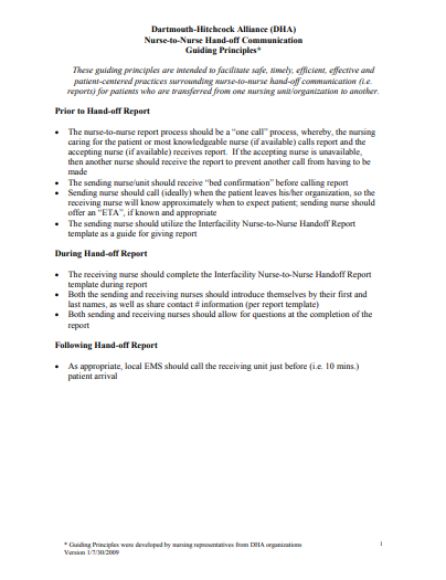
Nurses can make sure that handoff communications are well done by ensuring completeness of transferred information. They can make sure they write only relevant stuff in clear legible handwriting using expressive words. However, besides these, certain strategies can be followed to ensure things become all the more smooth.
- Double check your data regularly: There are a number of routine aspects which are often not covered by nurses. For example doctor visits, special instructions, pending treatment procedures, social meetings etc. Hence, one can make a master checklist and keep adding irregular points to it continuously.
- Create good relations and no communication breakdowns: In case a nurse does not enjoy good relations with other team members, misunderstandings due to communication breakdowns will be more common than can be imagined. It always pays, in the long run, to establish warm bonds with other colleagues.
- Streamline the process: Finally, it is best to streamline workflows as much as possible. This will ensure the effective execution of regular tasks.
What is handoff and types of handoff
According to academic literature, handoffs can be of many types. They do not have to be just a written sheet of a document being passed from one person to another. Let us take a look at some types of handoffs:
- Verbal handovers: Two or more nurses get together and talk to each other face to face. This helps in clearing a number of doubts. However, this method has also been known to be pretty cumbersome and time-consuming.
- Audio handovers: Rather than writing things down, one nurse might record the details in an audio tape. The recipient will then hear this audio and get all the required information. However, poor audio quality can lead to serious issues here.
- Written documents and bedside reports: Transfer of written documents about a person is usually done for administrative jobs and is an internal affair. However, bedside written reports can help in easily transferring information. They may also include inputs from the patient and his family.
Overall, bedside written reports are considered the best though they may be a bit difficult to implement.
What is a handoff in healthcare
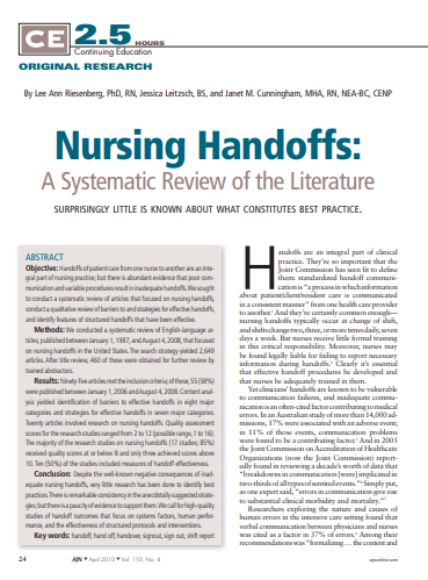
Handoff in healthcare usually involves the transfer of information or responsibility or both to other staff personnel. In the case of healthcare, the difference which comes about is that there are other factors which make the entire process more complicated.
Multiple transfers during the day, multiple disciplines and multiple subjective factors make handoffs in healthcare a special case. Not only this, but healthcare is also differentiated by its criticality. Issues in other businesses might lead to monetary or goodwill losses only. However, issues in healthcare might lead to the deaths of patients. They might lead to permanent disabilities of patients.
Hence, handoffs in healthcare have to be executed safely and responsibly.
How do you write a good nursing report
According to some people, writing a good nursing report is an art. There are a number of things you can learn to make it better over time. Some of them are given below:
- Format consistency: At times, nursing reports are pre-printed. They are like a form which ones need to fill up. In case it is not so, a nurse must rather remember to use the same format always. This way the next person will know what to expect and can get started faster.
- Write continuously: There is this one common issue with everything routine and mechanical. We tend to postpone them for later. However, given the criticality of the field here, it is best to write your notes down as soon as possible.
- Try to be unbiased: It is tempting to fall down the pit of subjectivity as a nurse and give in to your opinions. However, it is always recommended to be objective about whatever you note down.
It is advisable to get started with small steps. Gradually, they will become ingrained in your nature as daily habits.
How to use technology in handoffs
Technology has been changing the world for decades now. Every year, the world seems like a completely different place to live in. So, why not use the robustness and accuracy of technology in the healthcare field too. Following is a list of certain applications and software products which can help you get more efficient:
- Digital Nurse Assistant: The tool does exactly what it is named as. It works as an assistant to nurses and automates a number of tedious manual jobs for them. As such, they can focus on more important things in hand.
- Smart Sign Out: This is an application available in the Apple Play store for iPad users. It helps in sharing information regarding patients so that every authorized personnel can get to know about it instantly. Besides this, it has process efficiencies like auto-complete feature for diagnoses and medicines.
- Sign-out software: Provided by Kolkin, it consists of a suite of services like instant messaging among team members, electronic handoffs, case lists for doctors and article editors.
- Handoffs for Extended/Assisted Living: This is the first product developed by Carex Technologies. It focuses on communicating information between two sets of people: nurses amongst themselves and nurses with doctors.
- Tool Kits: Lastly, there are a number of tool kits for guiding handoffs available online which are free for download. They can be definitely used to one’s advantage easily.
How to teach handoff communication to nursing students
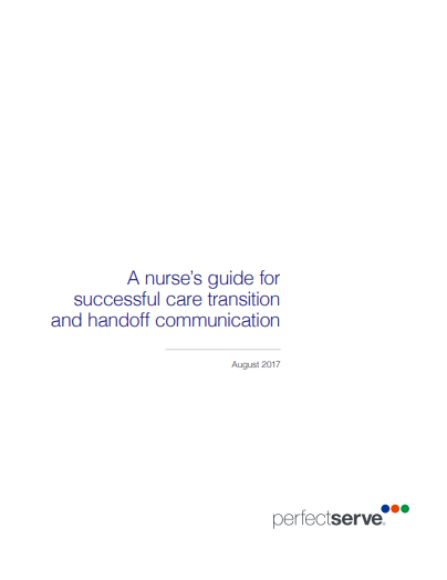
We all know that handoffs are super important procedures with many benefits and grave consequences. However, how do we teach this to nursing students? Even they need to recognize their significance. Here are some pointers which can help us:
- Importance of handoffs: Students must be assumed to be responsible for mature individuals in their own right. In that light, they must be told about the distinct benefits of handoffs and its fatal consequences. This will set the stage for further education in this regard.
- Mnemonics: They are a great learning method. Mnemonics like SBAR can help ensure that students always remember the key factors with regard to handoffs.
- Practical demonstrations: Nothing works better than live application oriented learning. Students must be asked to give handoffs to each other. This way, the concept will be permanently etched in their mind.
- Regular evaluation: Lastly, it is important to evaluate them continuously to look for learning loopholes and concept gaps.
Role of SBAR in nursing handoff
SBAR is an acronym which stands for Situation, Background, Assessment and Recommendation. In order to understand its significance completely, let us take a look at each one of them:
- Situation: With regard to handoffs, this would involve mentioning the current position of the patient and its primary complaints.
- Background: The background primarily includes the medical history of the patient.
- Assessment: The treatment methods being carried out, their results and any recent developments.
- Recommendation: Future course of action and any other suggestions.
SBAR is a good concept which covers all the basics of handoffs and is a great place to get started.
What is a shift report in nursing
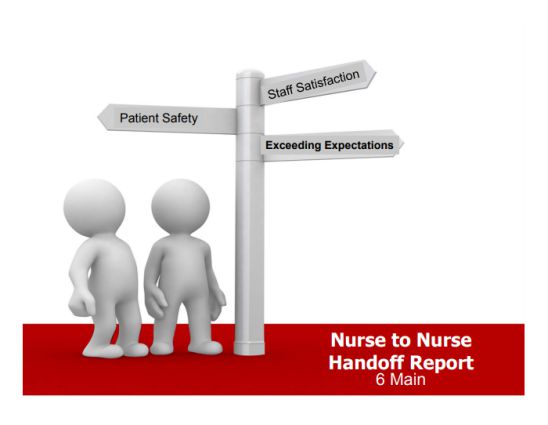
A shift report in nursing is prepared and passed on at the end of every shift to personnel responsible for the next shift. This ensures a smooth and complete transition from one team to the other.
Shift reports can be given by one team or person to the other by a variety of mediums. It might be oral or written communication or both. Usually, it is always advisable to have some kind of face to face interaction between all participants. Nowadays, both academic and professional circles have witnessed an increase in attention to the issue of shift reports and what can be done to increase their accuracy.
What is PACE nursing
Handoffs are a great concept in theory. However, the practical application of the same ends up requiring a lot more. One of the key elements is to standardize communication during patients’ handoffs. As such PACE, as an acronym, has been developed.
Patient/Problem (P)
The most important part of the entire process is the patient. This section contains all the information regarding the patient like its age, gender, medical history etc.
Assessment/Actions (A)
This section contains a list of all the treatments which the patient has been undergoing.
Continuing/Changes (C)
Here, the personal talk about steps to be followed by the next set of staff members so as to ensure continued treatment.
Evaluation (E)
Finally, every employee must mention his or her overall outlook regarding the client and the effectiveness of treatment procedures.
Conclusion
As is clearly evident, handoffs are unavoidable and reports during this phase are necessary. However, there are certain steps which can be taken to ensure the standardization of these reports. In the long run, this can lead to massive benefits and the drastic reduction in fatalities.